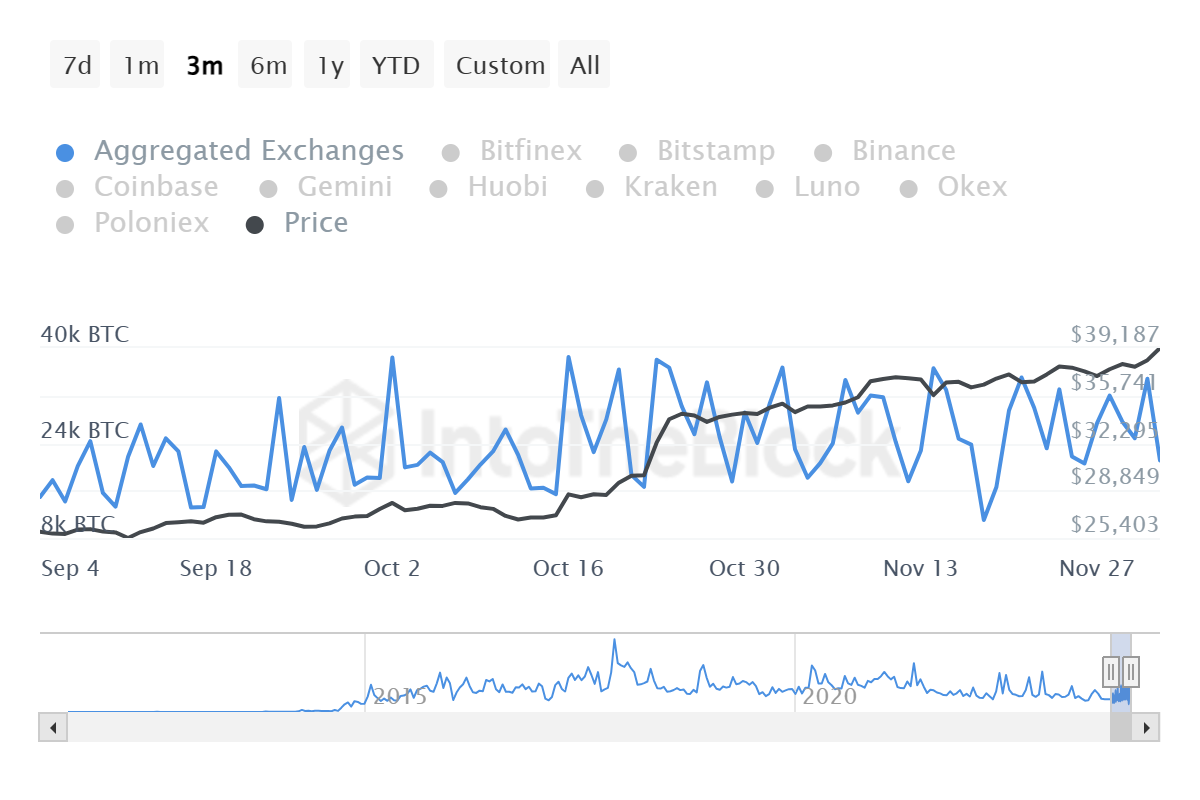- Bitcoin price remains bullish, up almost 60% since mid-September, confirming the “Q4 is the best month for BTC” narrative.
- BTC could extend to tag the $40,000 psychological level before a bigger dip to give late and sidelined investors buy opportunity.
- With strong downward support, GIOM shows there is one major area of interest between $42,556 to $67,413 threatening upside potential.
- Invalidation of the bullish thesis will occur the king of crypto breaks and closes below the $37,500 resistance level.
Bitcoin (BTC) price is trading with a bullish bias, riding on three themes. First, the fourth quarter has historically proven to be a good month for BTC. Secondly, there is strong anticipation for the approval of spot BTC exchange-traded funds (ETFs), with experts marking the calendar for between January 5 and 10. Third, the Bitcoin halving event slated for April 2024 remains something to look forward to.
Also Read: Bitcoin Weekly Forecast: Analyzing potential $30k corrections ahead of BTC ETF approval
Bitcoin price could wisp $40,000
Bitcoin (BTC) price is eyeing the $40,000 psychological level, and could wisp it before a correction. Several bullish drivers, including the Relative Strength Index (RSI), bolster thus outlook. For the RSI, this momentum indicator shows momentum is rising, with its position at 68 showing there is still more room to the north before the king of cryptocurrency can be considered overbought.
Further, the Awesome Oscillator (AO) is in the positive territory, with green histogram bars, suggesting the bulls are leading the market. Increased buying pressure, therefore, could see Bitcoin price extend from the current price of $39,462 (as of 8:00 AM GMT), clear the $39,778 range high before scrapping the $40,000 psychological level.
BTC/USDT 1-day chart
On-chain metrics to support Bitcoin bullish outlook
On-chain aggregator IntoTheBlock’s Global In/Out of the Money (GIOM) metric shows there is no supply barrier that will prevent the largest crypto by market cap from achieving its upside potential. Based on this on-chain metric, there is only one major area of interest between $38,670 and $39,701 that is filled by a high number of investors that had previously purchased BTC around this price level. Here, roughly 860,540 addresses are holding nearly 324,370 BTC tokens.
The next crucial resistance extends from $42,556 to $67,413 where 5.64 million addresses or investors had previously purchased 2.11 million BTC tokens at an average price of $52,282.
The representation also shows that at current prices, 85.60% of BTC holders are sitting on unrealized profit (in the money) while only 12.74% are sitting on unrealized losses (out of the money). Meanwhile, a negligible 1.66% of token holders are breaking even (at the money).
GIOM BTC
Also, the exchange inflows metric shows a declining trend, meaning the overall intention among token holders to sell BTC is reducing even as more continue to sit on unrealized profits. It points to a commitment to riding the uptrend, effectively giving Bitcoin price an abundance of buying pressure over seller momentum.
BTC exchange inflows
On the flip side, if profit-taking begins, with traders cashing in for quick gains, Bitcoin price could move south, with key levels to watch, including $37,500, $35,000, $32,500, $31,529, and in the dire case, the $30,000 psychological level. Such a move would constitute a 25% drop from current levels.
Bitcoin, altcoins, stablecoins FAQs
Bitcoin is the largest cryptocurrency by market capitalization, a virtual currency designed to serve as money. This form of payment cannot be controlled by any one person, group, or entity, which eliminates the need for third-party participation during financial transactions.
Altcoins are any cryptocurrency apart from Bitcoin, but some also regard Ethereum as a non-altcoin because it is from these two cryptocurrencies that forking happens. If this is true, then Litecoin is the first altcoin, forked from the Bitcoin protocol and, therefore, an “improved” version of it.
Stablecoins are cryptocurrencies designed to have a stable price, with their value backed by a reserve of the asset it represents. To achieve this, the value of any one stablecoin is pegged to a commodity or financial instrument, such as the US Dollar (USD), with its supply regulated by an algorithm or demand. The main goal of stablecoins is to provide an on/off-ramp for investors willing to trade and invest in cryptocurrencies. Stablecoins also allow investors to store value since cryptocurrencies, in general, are subject to volatility.
Bitcoin dominance is the ratio of Bitcoin’s market capitalization to the total market capitalization of all cryptocurrencies combined. It provides a clear picture of Bitcoin’s interest among investors. A high BTC dominance typically happens before and during a bull run, in which investors resort to investing in relatively stable and high market capitalization cryptocurrency like Bitcoin. A drop in BTC dominance usually means that investors are moving their capital and/or profits to altcoins in a quest for higher returns, which usually triggers an explosion of altcoin rallies.
Source


